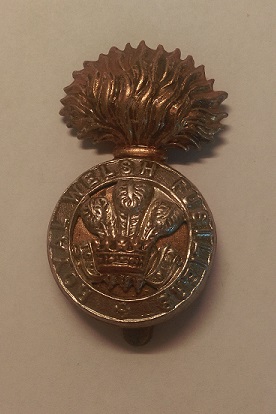1/1st Montgomeryshire Yeomanry facts for kids
Quick facts for kids 1/1st Montgomeryshire Yeomanry25th (Montgomery and Welsh Horse Yeomanry) Battalion, Royal Welsh Fusiliers |
|
|---|---|
| Active | 10 August 1914–29 June 1919 |
| Country | |
| Branch | |
| Type | Yeomanry |
| Role | Cavalry/Infantry |
| Size | Regiment/Battalion |
| Part of | South Wales Mounted Brigade 74th (Yeomanry) Division |
| Garrison/HQ | Brook Street drill hall, Welshpool |
| Engagements | Second Battle of Gaza Third Battle of Gaza Capture of Beersheba Capture of the Sheria feature Capture of Jerusalem Defence of Jerusalem Battle of Tell 'Asur Hundred Days Offensive Second Battle of Bapaume Battle of Épehy Final advance in Artois and Flanders Liberation of Tournai |
| Commanders | |
| Notable commanders |
Lt-Col Lord Kensington, CMG, DSO |
The 1/1st Montgomeryshire Yeomanry was a special army unit from Wales. It was formed during World War I to fight for the United Kingdom. First, it was a cavalry unit, meaning soldiers fought on horseback. Later, it became an infantry battalion, which means they fought on foot.
This unit was known as the 25th (Montgomery & Welsh Horse Yeomanry) Battalion of the Royal Welch Fusiliers. They were part of the 74th (Yeomanry) Division, nicknamed the 'Broken Spur Division'. They fought in the Sinai and Palestine campaign, helping to capture important places like Beersheba and Jerusalem.
Afterwards, they moved to the Western Front in France. There, they fought in the final battles of the war, including the tough Battle of Épehy. The unit earned two Victoria Crosses, which are the highest awards for bravery in the British military. The unit was officially ended after the war.
Contents
Starting the War: Mobilisation
When World War I began on 4 August 1914, the Montgomeryshire Yeomanry unit got ready for war. This process is called mobilisation. They gathered at their base in Brook Street drill hall, Welshpool. Their commander was Colonel Robert Williams-Wynn.
The Montgomeryshire Yeomanry was part of the Territorial Force (TF). This was a part-time army for home defence. However, on 10 August 1914, soldiers were asked if they would volunteer to fight overseas. Many soldiers from the Montgomeryshire Yeomanry agreed to go.
To help manage the large number of volunteers, new units were created. The original units that went overseas were called '1st Line' units. New '2nd Line' units were formed for those who stayed home or as reserves. Later, '3rd Line' units were also created to train new soldiers.
1/1st Montgomeryshire Yeomanry's Early Days
The 1/1st Montgomeryshire Yeomanry moved to East Anglia in England. They trained there and helped guard the East Coast from possible enemy attacks. By November 1915, the unit stopped using horses and became a dismounted unit. This meant they would now fight on foot.
Journey to Egypt
On 4 March 1916, the unit sailed from Devonport to Egypt. They arrived in Alexandria on 14–15 March. In Egypt, they joined other dismounted cavalry units to form the 4th Dismounted Brigade.
At first, they helped guard the Suez Canal. Then, they moved to guard Egypt's western border. This area was quiet, so the unit did not see any fighting there.
In early 1917, the British army in Egypt, called the Egyptian Expeditionary Force (EEF), needed more infantry soldiers. Infantry soldiers fight on foot. So, the dismounted cavalry units, including the 1/1st Montgomeryshire Yeomanry, officially became infantry. Their brigade became the 231st Brigade. This brigade then joined the 74th (Yeomanry) Division in March 1917.
Becoming the 25th Royal Welch Fusiliers
Cavalry units were smaller than infantry units. So, to create full-sized infantry battalions, two dismounted cavalry regiments were combined. On 4 March, the 1/1st Montgomeryshire Yeomanry joined with the 1/1st Welsh Horse Yeomanry. Together, they formed the 25th (Montgomery & Welsh Horse Yeomanry) Battalion, Royal Welch Fusiliers (RWF).
This new battalion was led by Lieutenant-Colonel Lord Kensington. He had previously commanded the Welsh Horse Yeomanry.
Fighting in Palestine
The 74th (Yeomanry) Division moved to Palestine. After the First Battle of Gaza failed, the division took over defensive positions. They were in reserve during the Second Battle of Gaza on 19 April. Although they faced some enemy shelling, they were not directly involved in the main attack.
For several months, the division trained and carried out patrols. One night, soldiers from the 25th RWF raided an enemy position outside Gaza. They used bombs and bayonets to scatter about 80 Turkish soldiers. They returned with prisoners and only two minor injuries.
The Battle for Beersheba
In May, Sir Edmund Allenby took command of the EEF. He planned a new attack, the Third Battle of Gaza, which began on 27 October. The 74th (Y) Division was part of a surprise night march to attack Beersheba on 30/31 October.
The 231st Brigade, including the 25th RWF, attacked the Turkish defences. They faced strong resistance. Acting-Corporal John Collins of the 25th RWF showed incredible bravery. He fought off many Turkish soldiers with his bayonet and helped wounded comrades. He also advanced with a Lewis gun to protect his unit. For his actions at Beersheba, Collins was awarded the Victoria Cross (VC), the highest award for bravery.
The 25th RWF and another RWF battalion suffered many casualties but also captured many prisoners. The attack on Beersheba was a great success.
Capturing Sheria
After Beersheba, the XX Corps, including the 74th (Y) Division, pushed north. On 8 November, the 231st Brigade helped capture the Sheria Position. This broke the Turkish army's left side, forcing them to retreat quickly.
Taking Jerusalem
The 74th (Y) Division then moved towards Jerusalem. The Turks launched strong counter-attacks on 27 and 28 November. The 74th (Y) Division arrived to help reinforce the British positions.
On 30 November, Major J.G. Rees led a company of 25th RWF to the village of Foqa. They found many Turkish soldiers cooking their morning meal. Major Rees, with only about 80 men, ordered the 450 Turkish soldiers to surrender. They did! He sent them to the rear with a small escort.
Major Rees and his 60 men then held Foqa against strong Turkish counter-attacks. They fought until 8:30 AM, when they were almost surrounded and had to retreat. On 8 December, the EEF launched its final attack on Jerusalem. Jerusalem surrendered the next day. The division then helped build roads and defend Jerusalem from Turkish counter-attacks.
Battle of Tell 'Asur
In March, the EEF prepared to advance into the Jordan Valley. The 231st Brigade was among the first to move. On the night of 8/9 March, the XX Corps attacked the high ground of Tell 'Asur.
The 25th RWF helped capture Turkish positions at Selwad. They then faced a difficult advance down a steep valley under machine-gun fire. They continued fighting through the night and next day, driving off Turkish counter-attacks. The Battle of Tell 'Asur was the 74th (Y) Division's last battle in Palestine.
Moving to the Western Front
In April 1918, the British army on the Western Front in France needed more soldiers. So, the 74th (Y) Division was sent from Egypt to France. They arrived in Marseille in May and then moved to the Abbeville area.
The division trained for the different fighting conditions on the Western Front. They learned about gas defence and bayonet fighting. The 25th RWF began active patrolling. On 17 July, a sergeant named Varley bravely took an enemy machine gun. The next day, Lieutenant Jowett led a raid and captured five prisoners without losing any men. In August, Major J.G. Rees became the new commanding officer of the 25th RWF.
Fighting at Bapaume
The Allies launched a major attack called the Hundred Days Offensive in August. On 29 August, the 74th (Y) Division moved south to join this offensive. On 30 August, they prepared for the Second Battle of Bapaume.
The division had little time to prepare. They had to take over trenches that were partly held by both sides. The attack was difficult, with heavy enemy machine-gun fire. The 231st Brigade was in reserve and did not get into the main fighting.
Pushing Towards the Hindenburg Line
The battle was a success, and the British army chased the Germans back towards their strong Hindenburg Line defences. On 7 September, the 231st Brigade led the advance. The 25th RWF helped capture trenches at Hargicourt, but faced heavy fire. The enemy was strong, and the brigade had to fall back.
The Battle of Épehy
The Battle of Épehy was planned for 18 September. The day before, German Mustard gas shelling caused many casualties in the 74th (Y) Division. The attack began at 5:20 AM, with soldiers advancing through rain and slippery ground.
The 231st Brigade reached its first objective quickly, taking many prisoners. The 25th RWF then moved forward but faced strong machine-gun fire from a German stronghold called the 'Quadrilateral'. Lance-Sergeant William Herbert Waring, a former Montgomeryshire Yeomanry soldier in the 25th RWF, showed amazing bravery attacking these machine-gun positions. He was awarded a VC after he died for his actions.
The 25th RWF suffered heavy casualties, losing many officers and non-commissioned officers. They were temporarily reorganised into two smaller companies. The battle was renewed on 21 September, but the 25th RWF again faced strong resistance and heavy losses.
Advance to the Schelde River
The 74th (Y) Division was tired, so they were sent back for a rest. However, they soon went back into action on 1/2 October. The Germans began to retreat, and the 74th (Y) Division followed them. On 3 October, they continued to advance without meeting much opposition.
On 15 October, the Germans started retreating again. The division followed them to the Haute Deule Canal. The enemy kept firing until 4:30 AM on 17 October, then disappeared. The 74th (Y) Division crossed the canal and continued their advance. They reached Camphin on 19 October. The Germans then held a strong line of barbed wire in front of Tournai, so the division stopped.
Liberating Tournai
On 4 November, the Germans suffered another big defeat. Their retreat continued. Early on 8 November, patrols from the 25th RWF entered the western part of Tournai. Civilians told them the Germans had left. However, all the bridges in the town were destroyed, and the enemy had machine guns on the eastern bank.
The Germans left Tournai the following night. By 7:00 AM on 9 November, engineers had built a footbridge across the Schelde River. The 25th RWF then became the division's advance guard, moving forward. They did not meet the enemy on 10 November. By 8:30 AM on 11 November, the advanced troops had crossed the Dendre Canal and liberated Ath.
The 25th RWF was north of Ath when the war officially ended with the Armistice with Germany at 11:00 AM on 11 November 1918.
After the war, the division helped repair railways. Soldiers began to go home in early 1919. The 25th (Montgomeryshire & Welsh Horse Yeomanry) Battalion, Royal Welch Fusiliers, was officially ended on 29 June 1919.
See also



